New
Year
Puerta del Sol, Madrid
Madrid: Setting the scene
I had come to Madrid to welcome in the New Year in the Puerta del Sol.
Most people do that with a group of friends, or with someone special in their lives. I was en route from Cuba back to Germany and although I would be celebrating New Year here alone – I would have been celebrating alone, even with friends had I been amongst them.
Being in the Puerta del Sol would see me experience one of the world’s top New Year Eve countdowns: alone or not, it was bound to be a memorable event.
My entry into Madrid reminded me that when I was here twenty years before, I was entranced with its architecture and sense of grandeur.
The original statue that once graced the top of the iconic Metrópolis Building was etched against a deep blue December sky.
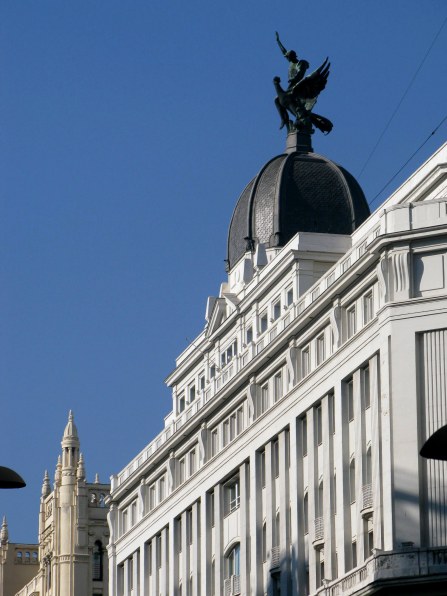
Further along, the Madrid skyline is like an avenue of sculpture.
In my travels I never forget to look up, to look down, and to look where others don’t. In this way I have captured some wonderful images that capture an aspect of a city not often noticed.
Once seen, I research the history and stories around the image. In this way I find that I can revisit the place in my memory with this new insight and see it as if through a prism with sparkling new dimensions.
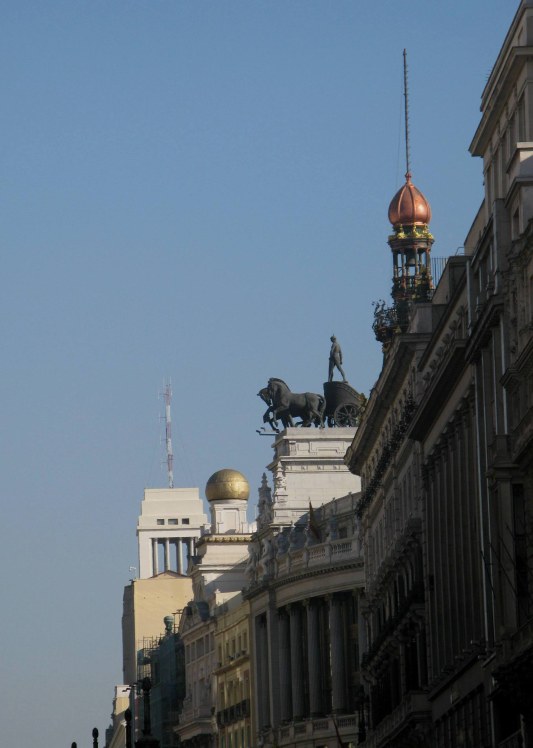
In Madrid, you must occasionally tear your eyes from the visual feast around you and look up, for there you will find grandeur and beauty that has a timeless stillness amidst the city rush.
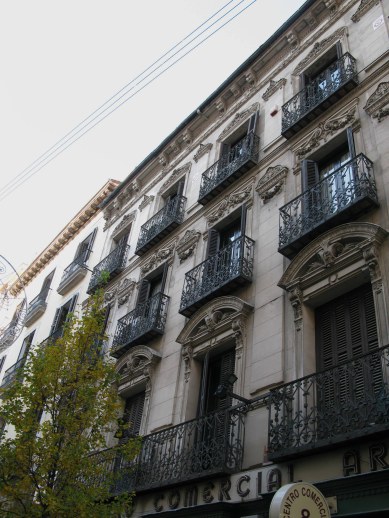
Carl Sandburg describes it well.
Yesterday and tomorrow cross and mix on the skyline.
The two are lost in a purple haze. One forgets, one waits.
La Mariblanca showing the way
to the Puerta del Sol, Madrid
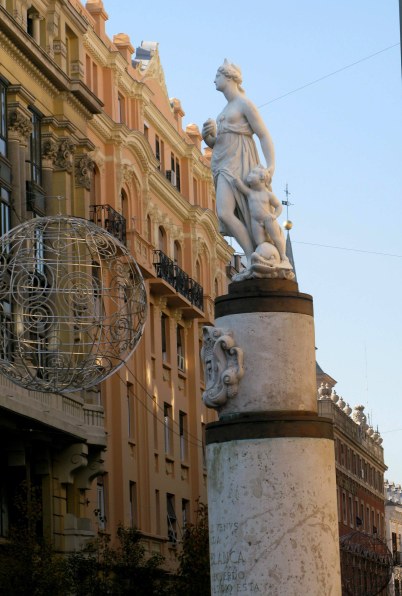
With hours to go until midnight, I knew I would need to spend many of
them in my one chosen spot in the Puerta del Sol so that my place would be
reserved for midnight– and I hadn't even fund a suitable place yet.
Setting off, I found a previous resident of the Puerta del Sol. This marble statue of La Mariblanca was bought in Italy in 1619 to adorn the new 18th century fountain at the Puerta. Mistaken for Faith, the lady is, in fact, Venus.
Venus being the Roman equivalent of Aphrodite – known to represent love, beauty, desire, sex, fertility, prosperity and victory, it is curious that Mariblanca is said to embody purity, fertility, and grace. Marketing is everything.
When the fountain was demolished in 1838, Mariblanca moved to her current home. She is loved and she is famous, and has many namesakes throughout Spain: it is a popular name for a girl - but this lady wasn’t giving up any secrets.
Madrid new and old architecture
harmoniously side by side
As I continued in the direction my Madrid map told me should bring me to the Puerta del Sol, I was struck with how well the old and the new had been combined in this church.
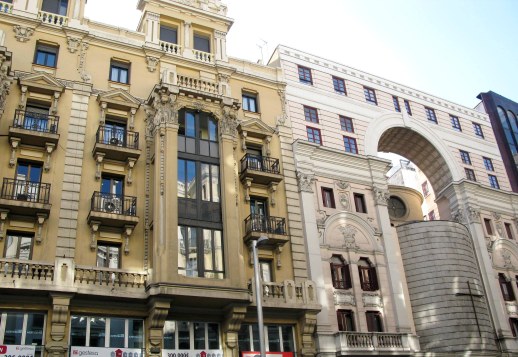
The simplicity of lines and simple cross were a perfect foil for its setting.
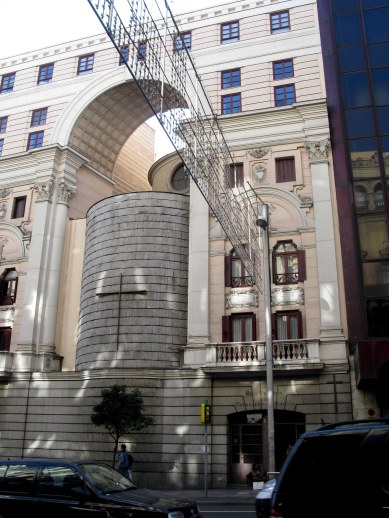
King Carlos in Madrid
on the Puerta del Sol
A mounted King Carlos was immobilised eternally in bronze against a deep blue December sky as the police engaged in conversation below.
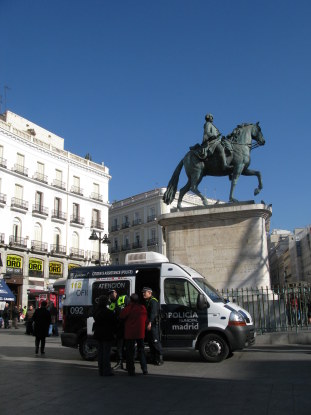
It is a popular belief that the placement of a horses hoofs in an equestrian statue give indication of how the rider died. Rearing means the rider died in battle. One front leg up means the rider was wounded in battle or died of battle wounds. When the horse is firmly grounded with all four hooves, the rider didn’t die in battle.
These are enticing beliefs, but should these definitions be so, many famous sculptures would have been erroneously cast. Sadly it’s an urban myth common only to the UK and the USA. King Carlos died at home in his palace.
King Carlos III preferred to be called Carlos (Charles) of Bourbon. Although he is responsible for creating Madrid as a capital very worthy of the name and equal to the best that Europe could offer, when he tried to compel the local resident madrilènes to wear French dress, the resulting riots caused him to be seen to not display what was described as “a great deal of courage”. Nevertheless, King Carlos made significant reforms across his dominion. Here in Madrid, he remains glorious in bronze, as well he might.
El Gordo on the Puerta del Sol
It was King Carlos’s judicious rule that led Spain to become a nation: he chose the colours of the flag, and inaugurated the national anthem.
However, perhaps the legacy that King Carlos gave to us all that is still much loved throughout the land (and abroad), is that he established the Spanish lottery.
The Spanish lottery is not called 'The Fat One' El Gordo for nothing.
El Gordo is perhaps the most distributive of all lotteries, with over 70% of all ticket holders winning something: money back if you match five numbers, or around €3 million for each of the 165 tickets that will share the winning numbers.
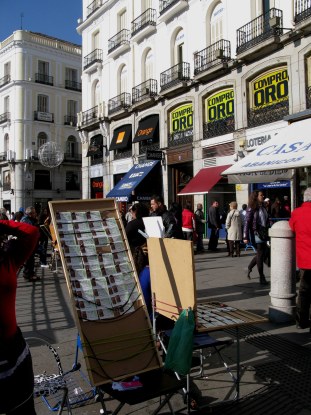
I had seen this near the Plaza Major Christmas Market, but there were queues all over the city as the date for the draw was getting closer.
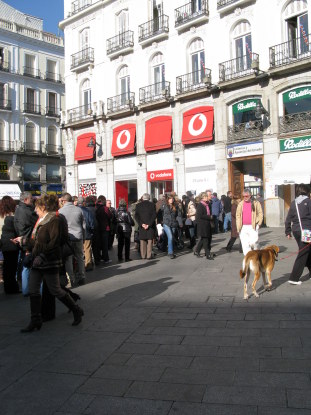
Landmarks on the Puerta del Sol, Madrid
- and an icon bear
The Puerta del Sol was immediately recognisable for the landmarks of the annual Christmas Tree of light and the Bear eating berries from the Arbutus Tree, commonly called the strawberry tree because of the likeness of its berries.
El oso y el madroño is an image seen on taxis, manhole covers, and many state buildings – for it is part of the coat of arms of the city.
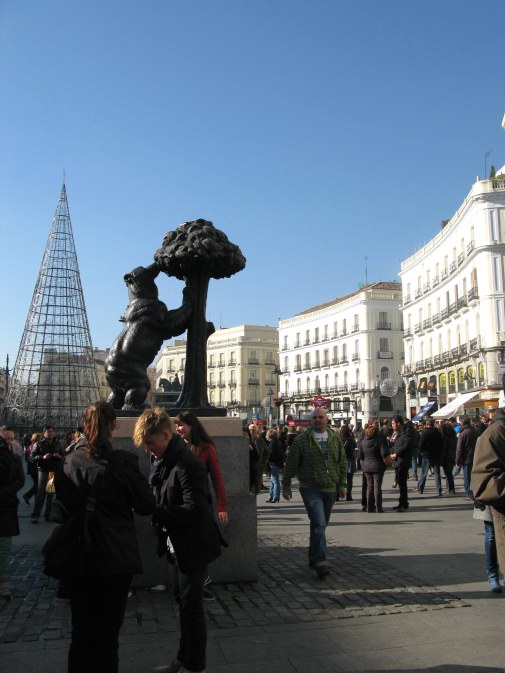
The bear seems happy eating the look-alike strawberries, but unlike strawberries, the berries of the Arbutus actually don’t have a great deal of flavour.
However, the fruit does well when distilled: both the Portuguese and the Spanish do so, creating in Portugal a strong brandy, and in Madrid madroño, a sweet liqueur.
Although in nature the Madroño Tree doesn’t like its roots being disturbed, this one was transplanted across the Puerta de Sol before being brought back again after reconstruction of its home area was completed.
Nevertheless, as you can see, here in the Puerta del Sol both bear and tree seem to be flourishing.
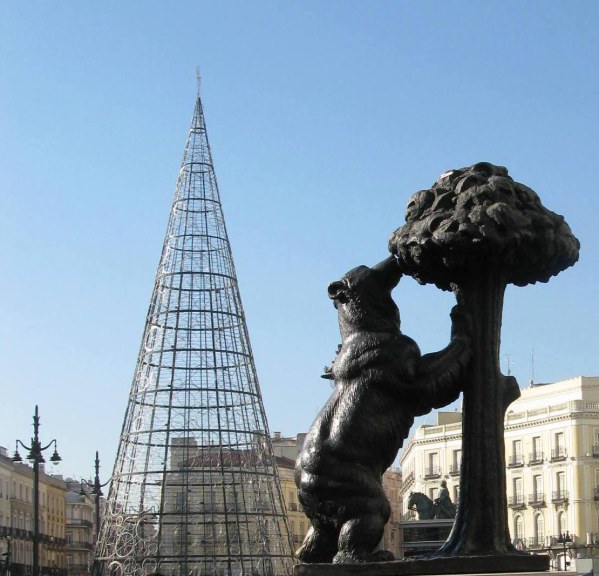
Kilometre zero in Madrid
on the Puerta del Sol
Turning against the setting sun, I saw the place where the New Year would be clearly escorted into our lives: the tower of the Real Casa de Correos, or literally the House of Royal Mail, more commonly referred to just as The Post Office, although it now fulfils a different function – housing the office of the President of the Community of Madrid.
Autonomous Communities became a part of Spanish law during the restoration of democracy. These communities operate under limited Home Rule and the President is elected by the legislature, and in Madrid this became effective in 1982.
I was at last at Kilometre Zero from which the distances of all roads in mainland Spain are measured.
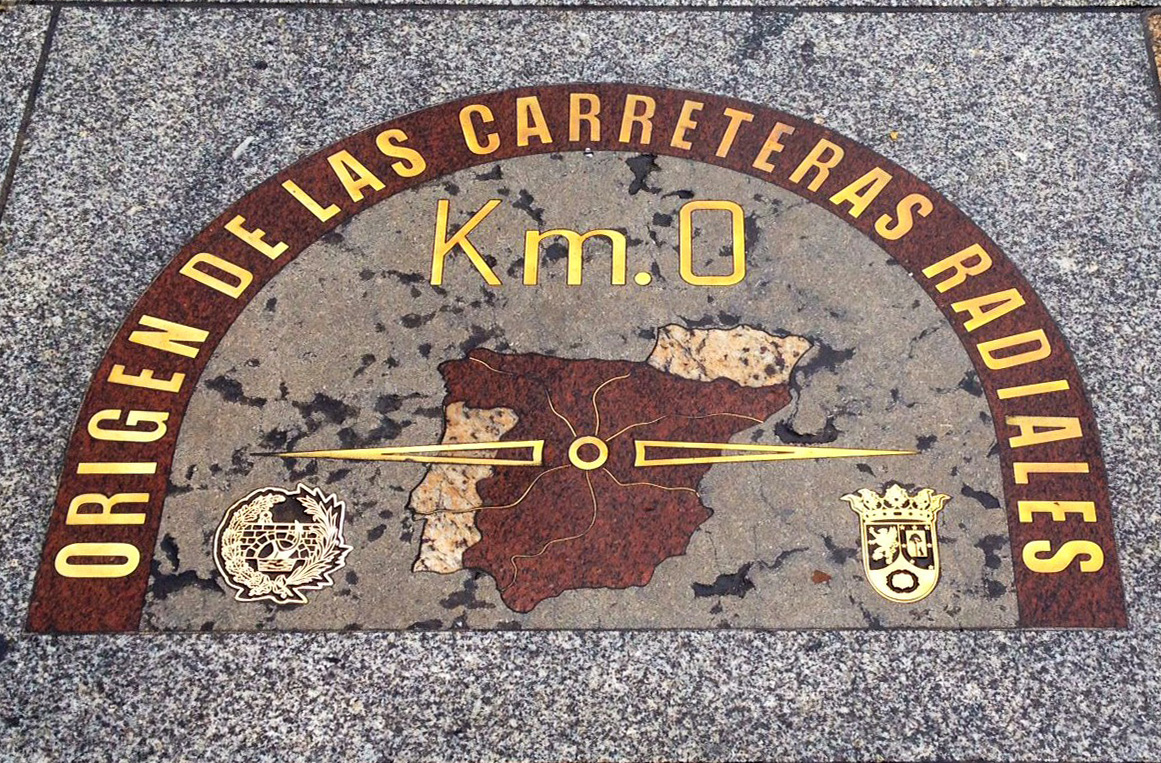
'Puerta del Sol Post Office' no more
- but known by that name world wide
The Real Casa de Correos is a lovely building with pleasingly symmetrical lines that make the clock tower, with its bell and golden ball, even more spectacular .
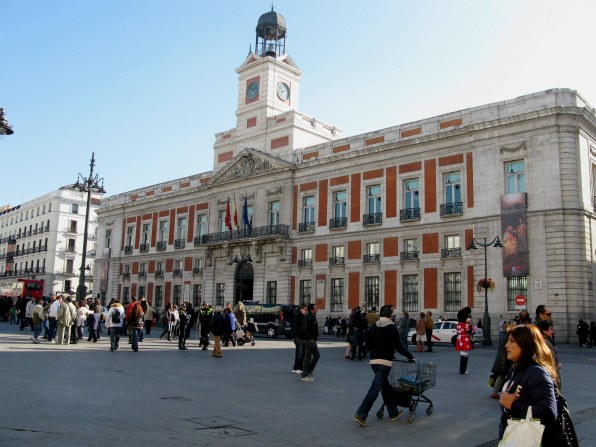
The golden ball of the Puerta del Sol or Gate of the Sun was so named because the gate in the Madrid city wall of the 15th century that was its ancient predecessor, faced east. That gate was decorated with the image of the sun, and so now, here we have our very own golden one.
Due to the Post Officeat that time being on the plaza, this area became a sort of cross roads for commerce, and a meeting point for locals and those visiting from abroad.
Where in the 17th and 18th centuries in London it was in the coffee houses that tales were told and deals were done, in Madrid it was said to be on the steps of the church of St. Philip on the square of the Puerta del Sol.
Those who met here on these steps became known as the best gossipers in the land – although the verb is easily manipulated from mentar – to mention, to mentir – to lie, so more often they were called the best spreaders of hearsay or lies of the Court.
Clocktower and golden ball:
New Year traditions in Madrid
on the Puerta del Sol
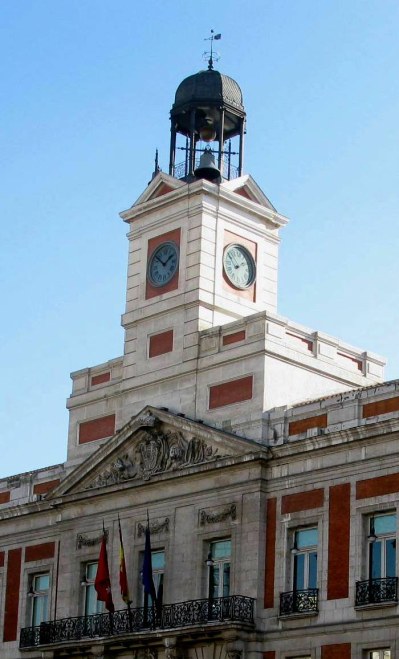
Horological science and magic
Later, I was to watch the ball appearing to magically lower at midnight.
Like most things that look effortless, it is backed by systematic care and year-long maintenance, culminating with three master craftsmen being together alone in the tower from 9pm on New Year’s Eve. Each has an allotted role: one for lowering the golden ball – which must be done manually, one watching the second hand, and the third overseeing the whole process.
These three master craftsmen belong to the Losada House in Madrid, who tend the clock weekly throughout the year. Since 1977 this has been the responsibility of Jesus Lopez Terrados and two of his colleagues who tend the famous clock regularly on a monthly schedule. It is also their great responsibility to ensure that each New Year is properly welcomed at the Puerta del Sol, an event that since 1962 has been televised to the nation and worldwide.
There is a rigorous schedule to keep and it is measured in moments:
- 28 seconds before
midnight – the golden ball that will fall under its own weight is released
- 20 seconds before midnight the only chime of the last year strikes and on the stroke of midnight the other 11 chimes peal, with three seconds between each other – each lasting 33 seconds
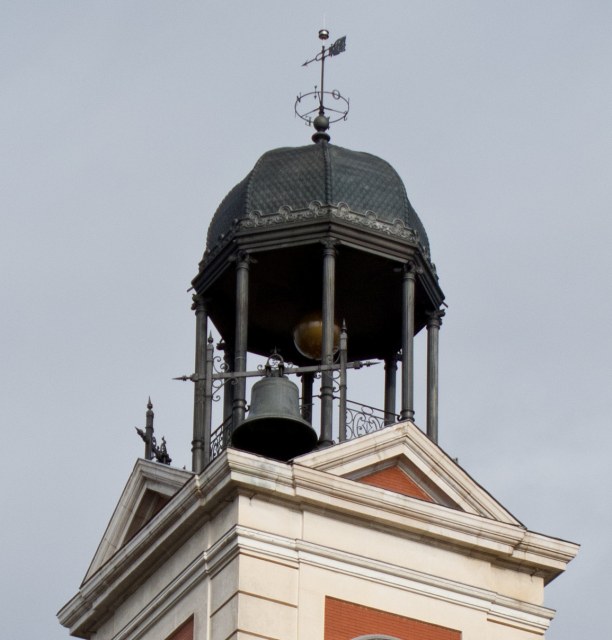
Importance of the Puerta del Sol clock
When the clock was first inaugurated in the 1800s, there were few pocket watches in the world and so people relied upon town clocks. The central Madrid clock that citizens had previously relied upon was notoriously inaccurate.
To rectify this, the Post Office clock in the Puerta del Sol was crafted in London by Spanish clock maker Jose Rodriguez Losada, a former official watchmaker for the Spanish navy, in an era when precision in clocks was essential to navigation.
Losada took three years to create this wonderful timepiece, and then donated it to the people of Madrid.
Since 1866, it has delighted the citizens of Madrid with it accuracy – and it was one of the first public clocks in the world to chime the quarter hours.
For many years, the clock on the old Post Office on the Puerta del Sol was Spain’s official timekeeper, against which all other clocks were set.
Preparing for midnight on New Year's Eve
on the Puerta del Sol
Having found the Puerta del Sol, I had to get my bearings and be sure that I had chosen a good spot, then head off to the supermarket to get my box of 12 grapes and bottle of Cava.
Looking around the Puerta del Sol I did my habitual scan of the skyline of any place and wasn’t disappointed.
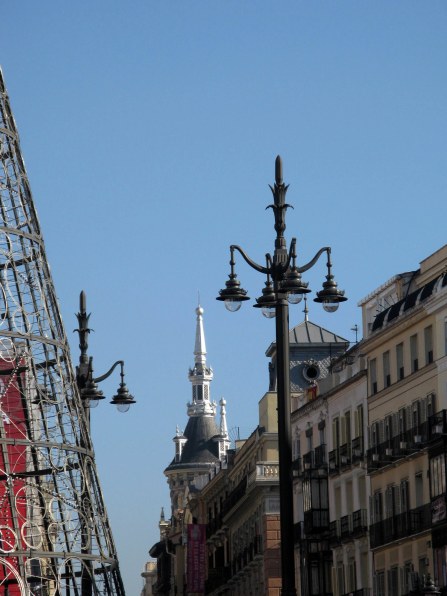
I headed back to the hotel to get warmer clothes and my camera tripod, for it was going to be a long wait.
On the way back to the Puerta del Sol, I popped into the food basement of El Cortes Ingles, one of my favourite department stores. It was only 6:30pm but already the grape boxes were heavily depleted. I had been warned to not leave it too late, as there is always a big rush at the end of the evening.
Happily, the Cava supply was still being replenished and I thankfully gathered my grapes and bottle before standing for a lengthy period waiting my turn to reach the totally swamped cashiers’ desk.
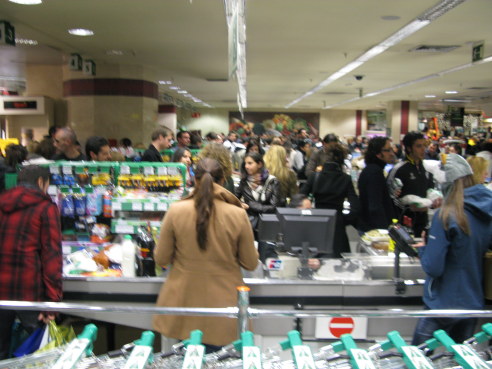
My chosen spot on the Puerta del Sol was with the Christmas tree behind me and King Carlos above.
Already the crowds were getting denser, and here was me still on the side streets thinking I was early.
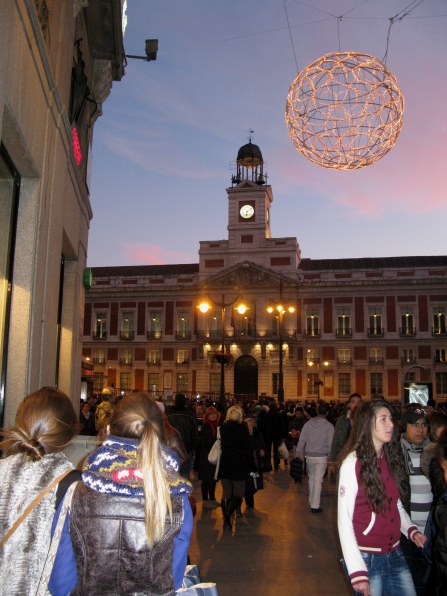
An elf had obviously wandered off his Christmas production in the Plaza Major to check out happenings on the Puerta del Sol.
The police presence was substantial yet relatively unobtrusive. I am sure there are pickpockets who also attend, just as some tourist sites warn – but generally, I never felt the crowd to be anything but one of outrageous bonhomie.
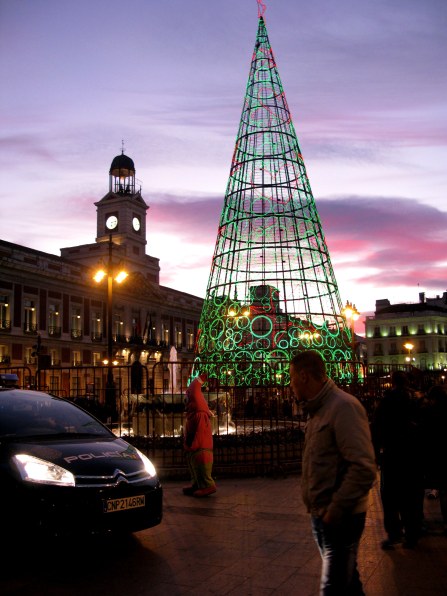
Media coverage
Parked on the edge of the Puerta del Sol were several TV outside transmission vans, with crews bustling about to make sure that their technical competence made impossible any outage of such a universally broadcast event.
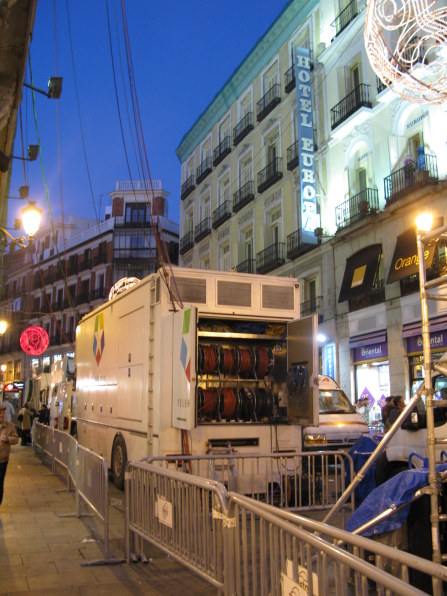
Between all these cables and the decorative street lights, it was amazing there was any power left in Madrid on New Year’s Eve.
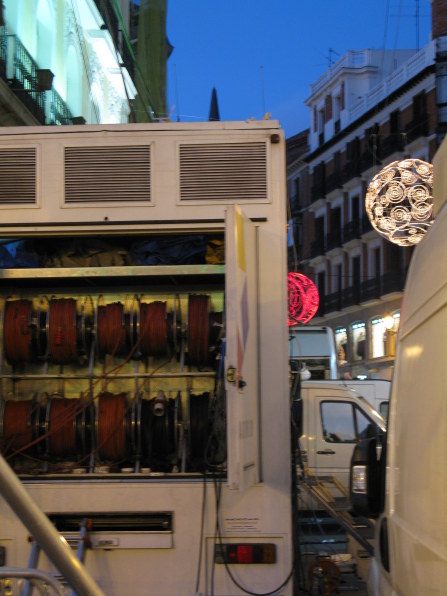
Looking up to see where the coverage point was situated, I saw a building laden with TV transmission equipment. The balconies and rooftops were spiked with masses of TV Cameras and news photographers.
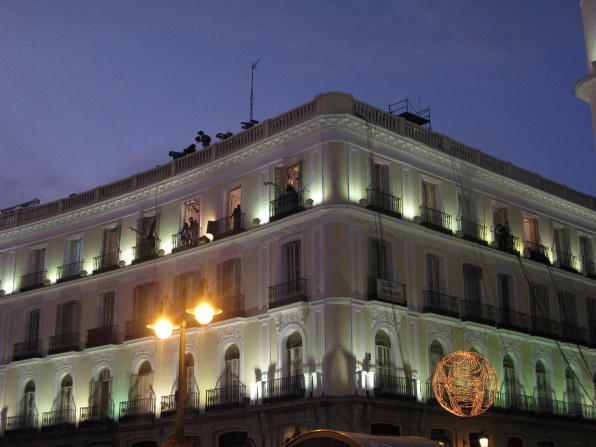
I emerged onto the Puerta del Sol from a side street just as the last sunlight of the year prepared a magnificent departure.
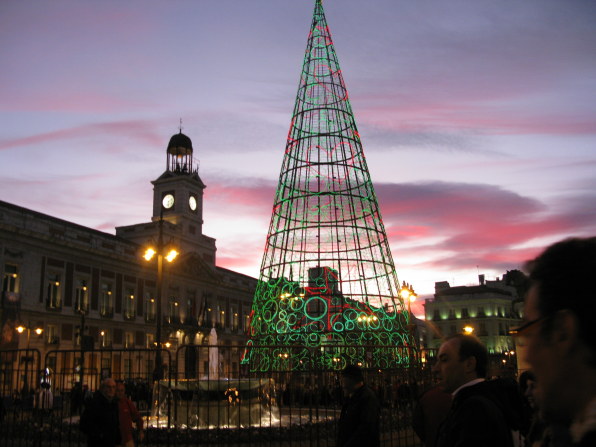
It was like a lady majestically dragging her crimson stole as she exited, stage right.
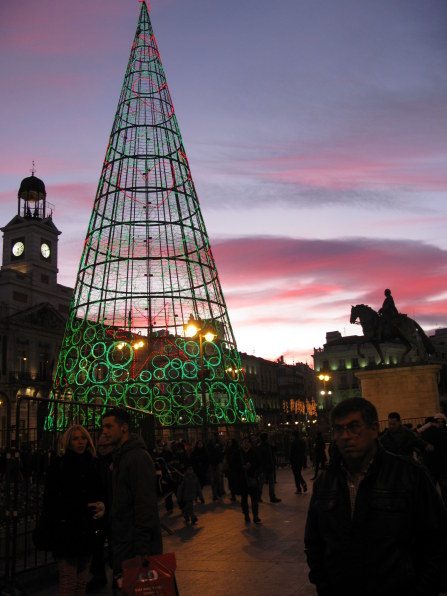
As it was still early, there was time for people to capture on their cameras an overview of the Puerta del Sol more generally, while above them the media selected their best camera angles from the building overlooking the plaza.
By now, most people had their paper carrier-bags with grapes and Cava and were headed for their own selected spot to wait out the passing of the old year and welcoming of the new.
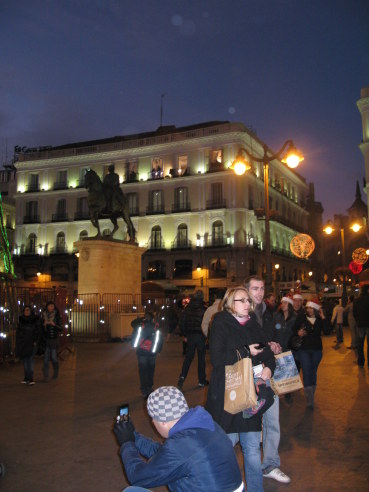
People were sporting their silly hats and even the more traditional angel halos and Santa Caps.
These fellows had chosen the same hat I had. The squirly top bobbed every time you moved, so it was a constant bit of resident festivity as well as keeping your head warm.
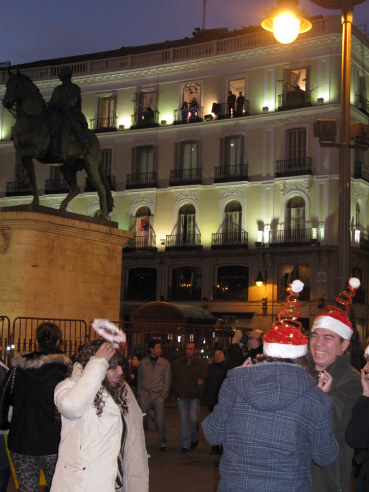
New Year Picnic on the Purta del Sol
By about 9:30 there wasn’t much more room to settle down as people had camped with their picnics and were already getting into the festive mood.
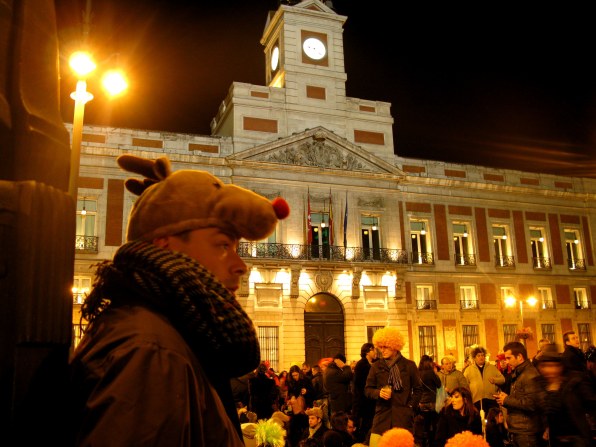
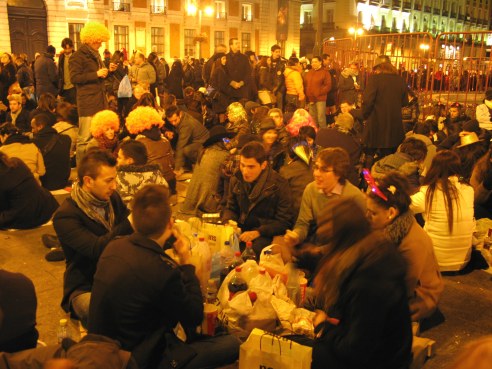
This was such a convivial and orderly crowd in which to wait four hours for twelve seconds of shared exuberance as the old year was bid farewell and we all welcomed the new with delight.
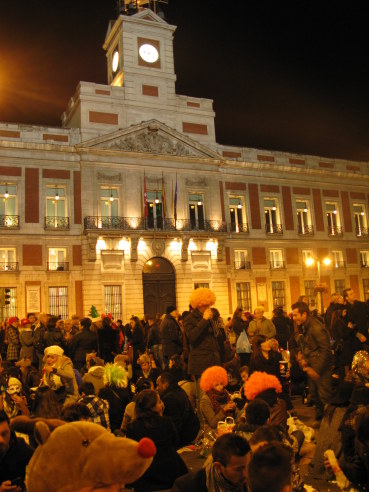
Some people had brought their own balloons to release at midnight.
I wondered if in the intervening period they would all write their wishes for the following year and send them heavenwards.
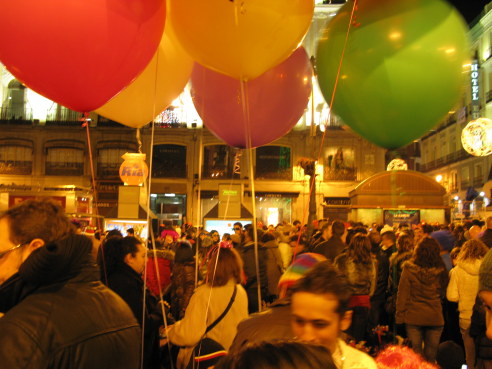
Keeping your balloons anchored in the meantime amongst the festivities was a big responsibility.
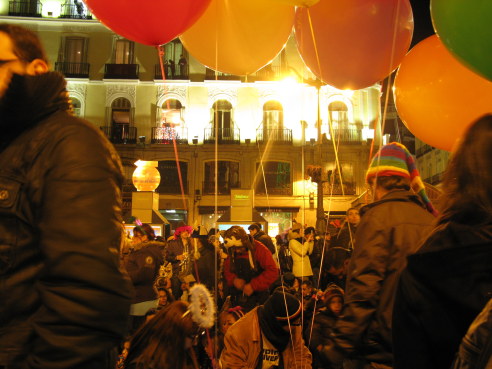
It wouldn’t be a public party without a banner or two and the Puerta del Sol festivities had theirs.
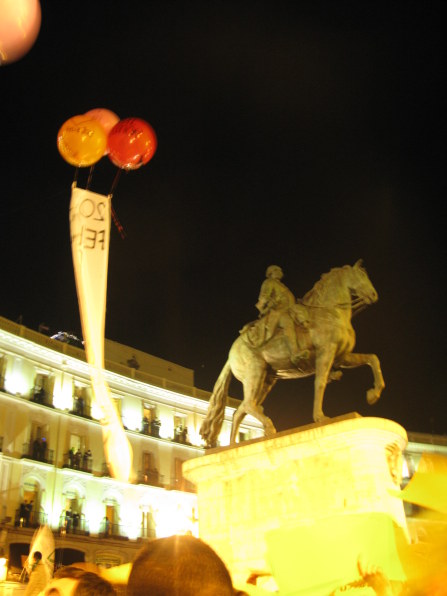
Happiness wishes floated on long banners that emerged here and there on the Puerta del Sol as crowds got denser.
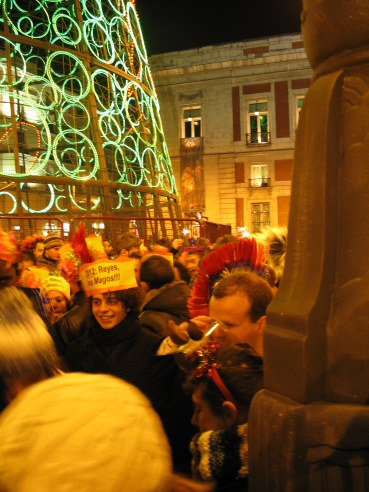
The Tradition of 12 Grapes
I first met the Spanish New Year Tradition of 12 Grapes in Mazatlan, Mexico. Living in St. Paul, Minnesota at the time, I was to drive friends to the airport for a holiday there, and the night before I did so they talked me into coming along as well. I had then managed with some difficulty to deal with the 12 grapes at midnight - and here it was to challenge me this New Year's Eve on the Purta del Sol in Madrid.
The tradition is that you eat a grape for each chime, to ensure that each of the ensuing 12 months will be healthy and happy.
Locals shared suggestions about how to get all 12 grapes down. The problem is that if you try to swallow you just cannot keep up, so you bite and store them in your mouth.
I later discovered that the problem with this is that half way through, you have a tendency to feel like a chipmunk with grapes in your cheek, and you get the giggles.
In the Puerta del Sol it proved impossible to keep the camera tripod steady, but in the process of it being nudged in this direction and that, I met some great people from Tunisia and Morrocco.
The photo proves just how the crowd was gently jostling. Even at this early stage of the evening with an hour still to go, the pictures became quite blurry. We were being constantly gently nudged by crowds of others doing the same sort of group photo with not quite enough space to do so.
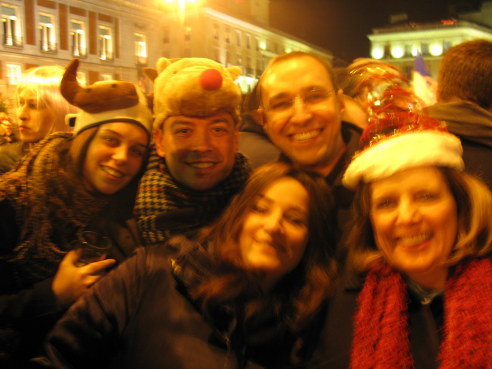
Midnight: New Year's Eve
on the Purta del Sol in Madrid
Finally, there is a mighty roar as the golden ball drops on the last chime of midnight.
It is then that the first sound of the New Year in Madrid fills the Puerta del Sol: fireworks and thousands of Cava bottles going pop.
I came to Madrid alone, because one can feel even more alone at New Year and in other moments of communal celebration.
If you are with friends and family and without your own bond of sharing that special time without your someone special, the festive nature of the occasion seems to accentuate that feeling of isolation.
The option on such days of universal celebration is to take the easy road and go with friends to an anonymous place to drink and dance and feel even more alone – or stay at home and hope the event passes you by.
Instead, I chose to go to a foreign place – a place that was special and would make a unique memory forever.
This New Year's Eve was the end of a formative month with no plan alone in Cuba.
There, I had found that the isolation from thing familiar had caused things I thought forgotten to rise to my consciousness to be dealt with once and for all in the silence of being on my own in a strange land. It was a wonderful experience of letting go of the past and serenely setting out towards whatever the future might hold.
You can buy the book of the trip here: The Cuban Approach
Shared greetings and friendship
In Madrid on New Year’s Eve, I didn’t get the much hoped for spectacular photos. Instead, I met new friends in the Puerta del Sol and we were all there together, whether with partners or not – just strangers celebrating our lives and our future possibilities, our dreams for the year ahead, and the happy memories the passing year had gifted to us.
Together with strangers I welcomed a New Year – full of things that have never been before.
The image is one that will remain longer than any photo.
On every New Year's Eve we each have the same gift:
365 new days ahead
365 new possibilities






